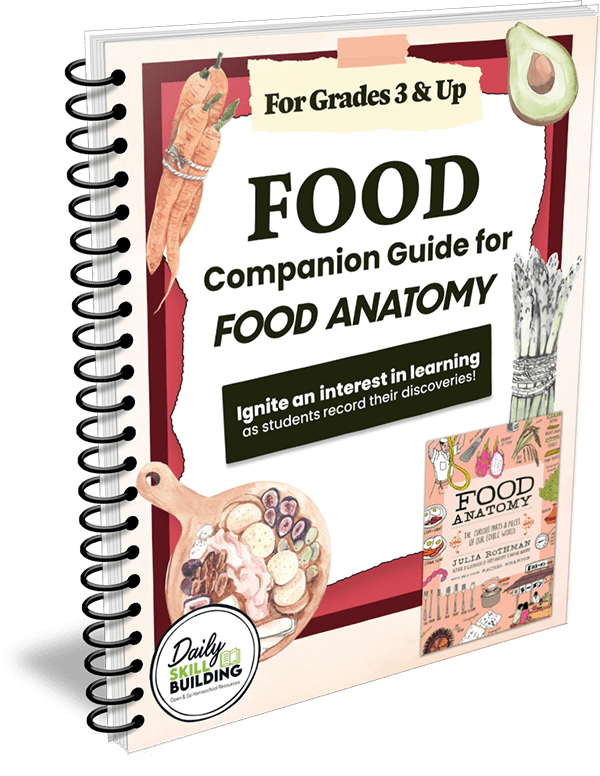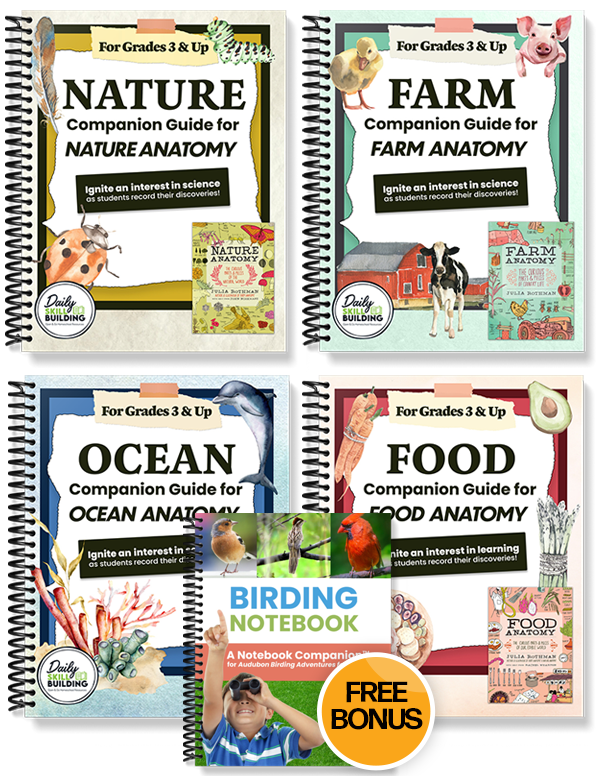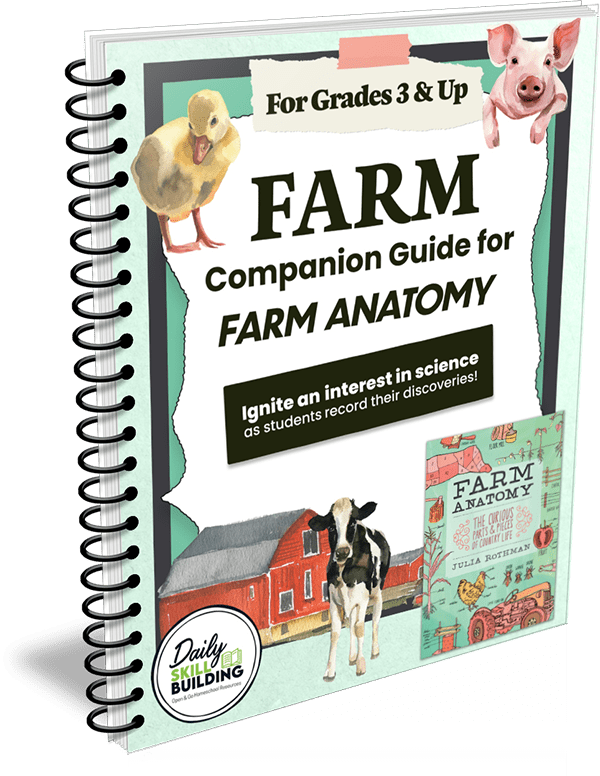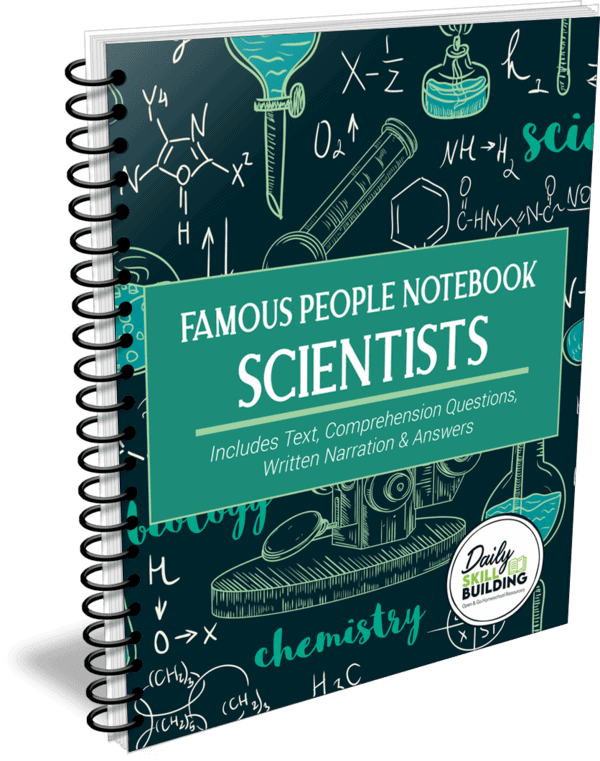Food Notebook - A Notebook Companion™ to Food Anatomy
Get ready to eat your way around the world! Start your adventure with the history of food and end with a world tour of what other countries call good eats. Who knew the best way to learn social studies is through your stomach? Food Anatomy will whisk you around the world to study fruits, vegetables, grains, meat, dairy, snacks, seasonings, drinks, and desserts.
Don’t forget to save room for The Food Notebook, a publisher-approved Notebook Companion™ to Food Anatomy by Julia Rothman, sold separately.
Food Anatomy is part of the popular Julia Rothman series by Storey Publishing. Get the most out of this tasty study with Food Notebook.
The Food Notebook follows along with the topics in Food Anatomy and includes written narration, places to sketch food and kitchen tools, labeling and diagramming, and more!
This is your student’s chance to have fun diagramming the “anatomy” of a banana split, learning about how coffee is processed, discovering kinds of snacks and meals you can eat in other countries, and much more!

Topics Covered in Food Anatomy
- Chapter one: history of food, food terminology, place settings, kinds of forks and spoons, international cupboards, traditional ovens, stoves, refrigeration, fermentation
- Chapter two: plant family, fruit facts, how flowers become fruit, produce, plant families, celery, obscure food items, tropical fruit, berries, common tree fruit terms, bananas, citrus fruit, salad greens, fungi, truffles, yams and sweet potatoes, beans, shelling, nuts, tofu
- Chapter three: grains, corn, rice, bread, dough, baking, sandwiches, pasta types and making pasta, Asian noodle dishes, dumplings, pancakes
- Chapter four: prime cuts, how to cook meats, charcuterie plates, sausage, butchery tools, meat dishes, food fish, filleting a fish, roe, fresh fish, clams, kinds of sushi, whole chickens, eggs (including egg lingo)
- Chapter five: dairy, milk, dairy terms, how to make butter, buttermilk pancakes, cheese, making cheese, types of cheese, curds
- Chapter six: snakes with funny names, French fries, hot dogs, meat on a stick, food trucks, street food, pizza, taqueria terminology
- Chapter seven: spices and spice blends, sugar, olive oil, mustard, making vinegar, salt, pepper
- Chapter eight: coffee, espresso, tea, brewing, carbonated drinks, fermented beverages, making wine, wine tasting, distillation, glassware, and more
- Chapter nine: common cakes, cake making, ice cream, sundaes, cookies, chocolate, worldly treats, candy, candy shops, pasteries, pastry tools, pies, donuts, and other sweets
Like our other open & go curriculum, there is no prep-work involved – you simply grab your copy of the book and your Notebook Companion and work at your own pace.
We also have Notebook Companions™ for other volumes in the Julia Rothman Series. Click here to view them.
-
*Digital Product










Yolanda Talavera –
I was looking for a supplement for my 8th grade son that would go along with his Home Economics course and this fit the bill. The Food Anatomy book is a wonderful addition to any home and the notebooking pages are perfectly laid out with the book. This is definitely an open and go resource. This is such a great way to teach anyone about other cultures, which is my favorite part. My son is enjoying this very much!
[email protected] –
We have always loved the Rothman series and having the companion notebooking packets is fantastic. I have older children and we still like using the series. I am learning a lot as well.
Amberly May –
When I first purchased the Food Anatomy book by Julie Rothman, I couldn’t figure out how to incorporate it into our homeschool schedule. But when I purchased the Companion Guide notebook, it all came together! The Companion Guide to Food Anatomy is a great addition to our homeschool lessons!
Aspen Allen –
Currently this is a bit higher level than we are ready for but I couldn’t pass it up. We are a foodie kind of family and I am hoping that this inspires my kids to have a passion for food! Looking forward to the future when we can put this to good use!
Janet Germiller –
I LOVE the Julia Rothman books and my daughter enjoys looking at them. Yet, as a homeschooling mom, I wanted something that makes her look at the information on each page more closely. I’m so glad that Daily Skill Building made this workbook. My daughter is in middle school and considering a food related career. This makes an amazing elective!
C Sanguinetti –
This is the book that launched my family into the world of notebooking and I am so happy to have found it. I am so pleased with the quality of this book and the fact that I don’t need to prep for the lessons. My child has an interest in cooking, which is why I thought this book would be a good resource. Now, she is even more interested in international dishes and wants to try new foods, which is amazing seeing that she can be picky with what she eats. Overall, this is a fantastic homeschool resource.
T Taylor –
My daughter is really loving using this journal along with the Food Anatomy book. She especially likes drawing in it daily. I have really appreciated that this is something she can do on her own, and it gives such enjoyable practice in writing and drawing about what she is learning.
A Wolf –
I am in love with the Julia Rothman books but wasn’t sure how to go about incorporating them into our homeschool day. Enter Daily Skill Building Notebook. This journal is amazing. The amount of time that must have gone into building this notebook is unbelievable. The Farm book was the first one I purchased and I was so blown away I knew I had to get the Ocean and Food Anatomy journals as well. My 11 and 14 year olds have really enjoyed these journals! I cannot wait to use this one for our Health unit later this year. I highly recommend them!
Marcia Cabaday –
A great addition to our homeschool health class. Thank you for making such great content for us to use.
CT –
I have a child who absolutely loves FOOD, so I thought the Food Notebook would be the perfect notebook to start with.
The Food Anatomy book is engaging from the very beginning and my son (who loves to eat with his fingers) happily learnt and then demonstrated the correct way to eat with his fingers.
In the Food Anatomy book your child (and you) will learn about the different food, culture and traditions of various countries. There are even some handy tips, techniques and recipes.
The Food Anatomy notebook is a wonderful companion to the Food Anatomy book that reinforces learning and serves as a lovely record of work done that you and your child can be proud of.
Carrie Fernandez –
My husband learned how to cook when he was a kid (begrudgingly) and I reap the benefits of it to this day! It’s great to see kids being foodies at a young age!
Beth Cruse –
Really good notebook
Yvie –
We love the beautiful Julia Rothman books! My children have been working through the notebooks for Nature, Farm, and Ocean Anatomy, but I wanted to work through Food Anatomy…just as mom-learning. I am very impressed at the quality of these notebooks and how much they help the student to retain! By writing notes and drawing the graphics into your notebook, it helps the brain cover the information in more ways, thus ensuring you’re more likely to remember it.